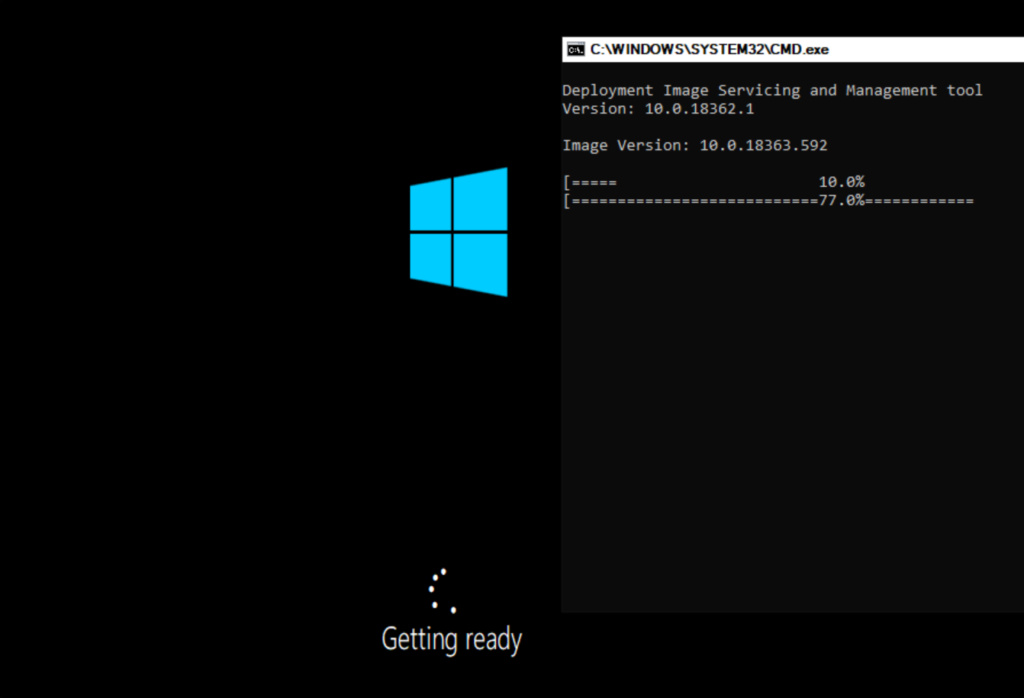Hello to all,
the intent of this topic is to bring some clarifications about these two features and fill up the lack of information.
Below are my findings (Windows 10 Pro + current cumulative update integrated, WR 2.3.0.0) and someone expert may want to correct me if I am saying something wrong.
One option excludes the other and when both are selected, folder cleanup takes precedence.
------------WinSXS Folder cleanup (install.wim)------------
As stated in the field info, it breaks windows updates, windows features, windows error reporting service and Modern Apps UI View.
However...
- windows features can still be enabled/disabled, but this must be done through WR. Once we are in the OS, every attempt to change features will return an error.
- Windows updates (like removal tools, definitions and others except cumulative updates) can be still successfully installed through a nice app called WuMgr.
- I didn't experienced any breakage on Modern Apps UI View. When I open the start menu they all display correctly and I can move, delete and perform any operation on tiles. Therefore someone that has this problem could explain what he is experiencing so that we can all find out if there is some component responsible for this.
The Windows update and related components I removed are:
Windows Error Reporting Service
Windows Update service (PLEASE NOTE: I WAS NOT ABLE TO REMOVE THIS SERVICE UNTIL I DISABLED MODERN UI APPS PROTECTION. I AM NOT SURE IF THIS SERVICE IS STILL NEEDED FOR THEM OR IT WAS MY FAULT FOR WORKING ON AN ALREADY REDUCED ISO!)
Windows Update Medic service
Update Orchestrator service
Background Intelligent Transfer Service
Modern UI Apps - settings - Windows Updates
hide "update and Security - Windows Update
server initiate healing
Azure active directory
Collaboration data objects (CDO)
Data deduplication
Internet Explorer (Engine)
Gracenote (GNSDK)
Results:
> Total Install Size ("C:\" drive): 7.2 gb
> WinSXS folder size: around 64 Mb
------------WinSXS Folder compression------------
The only algorithm that made difference in size is LZX. It adds 10 minutes to the building process, but also in the install process. During "Getting ready" step, it starts the servicing tool and what I believe should be the compression task, can take an hour or two before booting into the desktop (I attached a picture).
All windows update related components above has been restored.
Results:
> Total Install Size ("C:\" drive): 8.65 gb
> WinSXS folder size: 4.90 Gb (don't know why does not show the real compressed size)
> Windows Update works (except cumulative ones, but these are nearly impossible to install in extreme presets, no matter if all optimizations are disabled)
> Windows features works
> Modern UI app view works
After installing a malware removal tool from the WU, I saw the WinSXS folder growing from 4.90 Gb to 5.01 Gb, but strangely the total install size has grown from 8.65 Gb to 9.81 Gb and that is not good (not sure if this really depends from updates, I have just reinstalled the above iso and I experienced the same)
However is not clear in what way the compression is preserved. I am out of idea and hope that someone know the response.
------------CONCLUSIONS------------
So, in this test the folder cleanup only gained additional 1.45 Gb in install size compared to maximum folder compression (and if other better algorithms can be adapted, the difference could be pretty much non existent).
This is something that users should take in consideration before deciding what to choose, especially considering what breaks the folder cleanup. Yes, compression slows down a lot the installation and this is not good for people that often reinstall a winreduced iso. However I suppose that the compression task can be done directly from within the operating system, but I have not been able to find out what is the required DISM command. Someone know?
I should also say that in a topic winterstorm said that the folder compression breaks windows update (please if there is this risk, inform the user through the field info in WR app!), but I think he was referring to cumulative updates which in extreme presets don't work in any case. Please correct me if I am wrong in this assumption!
This is just a basic quick test and I am not sure if there are any other pros and cons.
Hope that other people can contribute with their experience.
Thanks to all!

the intent of this topic is to bring some clarifications about these two features and fill up the lack of information.
Below are my findings (Windows 10 Pro + current cumulative update integrated, WR 2.3.0.0) and someone expert may want to correct me if I am saying something wrong.
One option excludes the other and when both are selected, folder cleanup takes precedence.
------------WinSXS Folder cleanup (install.wim)------------
As stated in the field info, it breaks windows updates, windows features, windows error reporting service and Modern Apps UI View.
However...
- windows features can still be enabled/disabled, but this must be done through WR. Once we are in the OS, every attempt to change features will return an error.
- Windows updates (like removal tools, definitions and others except cumulative updates) can be still successfully installed through a nice app called WuMgr.
- I didn't experienced any breakage on Modern Apps UI View. When I open the start menu they all display correctly and I can move, delete and perform any operation on tiles. Therefore someone that has this problem could explain what he is experiencing so that we can all find out if there is some component responsible for this.
The Windows update and related components I removed are:
Windows Error Reporting Service
Windows Update service (PLEASE NOTE: I WAS NOT ABLE TO REMOVE THIS SERVICE UNTIL I DISABLED MODERN UI APPS PROTECTION. I AM NOT SURE IF THIS SERVICE IS STILL NEEDED FOR THEM OR IT WAS MY FAULT FOR WORKING ON AN ALREADY REDUCED ISO!)
Windows Update Medic service
Update Orchestrator service
Background Intelligent Transfer Service
Modern UI Apps - settings - Windows Updates
hide "update and Security - Windows Update
server initiate healing
Azure active directory
Collaboration data objects (CDO)
Data deduplication
Internet Explorer (Engine)
Gracenote (GNSDK)
Results:
> Total Install Size ("C:\" drive): 7.2 gb
> WinSXS folder size: around 64 Mb
------------WinSXS Folder compression------------
The only algorithm that made difference in size is LZX. It adds 10 minutes to the building process, but also in the install process. During "Getting ready" step, it starts the servicing tool and what I believe should be the compression task, can take an hour or two before booting into the desktop (I attached a picture).
All windows update related components above has been restored.
Results:
> Total Install Size ("C:\" drive): 8.65 gb
> WinSXS folder size: 4.90 Gb (don't know why does not show the real compressed size)
> Windows Update works (except cumulative ones, but these are nearly impossible to install in extreme presets, no matter if all optimizations are disabled)
> Windows features works
> Modern UI app view works
After installing a malware removal tool from the WU, I saw the WinSXS folder growing from 4.90 Gb to 5.01 Gb, but strangely the total install size has grown from 8.65 Gb to 9.81 Gb and that is not good (not sure if this really depends from updates, I have just reinstalled the above iso and I experienced the same)
However is not clear in what way the compression is preserved. I am out of idea and hope that someone know the response.
------------CONCLUSIONS------------
So, in this test the folder cleanup only gained additional 1.45 Gb in install size compared to maximum folder compression (and if other better algorithms can be adapted, the difference could be pretty much non existent).
This is something that users should take in consideration before deciding what to choose, especially considering what breaks the folder cleanup. Yes, compression slows down a lot the installation and this is not good for people that often reinstall a winreduced iso. However I suppose that the compression task can be done directly from within the operating system, but I have not been able to find out what is the required DISM command. Someone know?
I should also say that in a topic winterstorm said that the folder compression breaks windows update (please if there is this risk, inform the user through the field info in WR app!), but I think he was referring to cumulative updates which in extreme presets don't work in any case. Please correct me if I am wrong in this assumption!
This is just a basic quick test and I am not sure if there are any other pros and cons.
Hope that other people can contribute with their experience.
Thanks to all!


